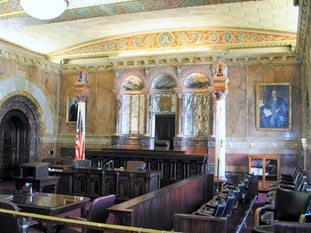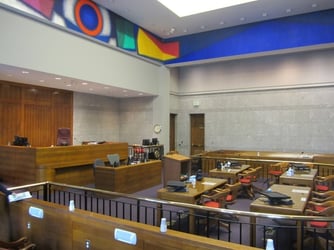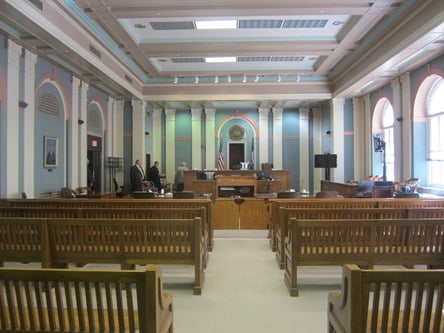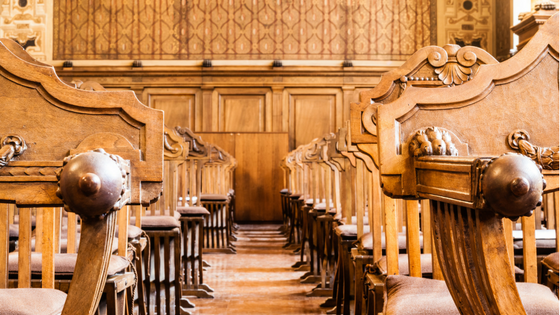Years ago, during a courthouse needs assessment, I had a passing conversation with a defense attorney while I was evaluating courtrooms. She noticed that I was taking space measurements and photographs, and commented that the standards for courtroom design should change because participants often find them overly intimidating. I was thinking to myself, “Isn’t that a good thing – to sit in a sobering space where defendants can feel the weight of their circumstances in a room that reflects the values of the judicial process?"
The attorney explained that a courtroom can be so large that it makes an individual feel small. So formal that it is imposing to the participants. So ornate that it is not relatable to the average person, especially those from less affluent backgrounds. From her point of view, the size, formality, and decor combine to produce an intimidating space – and she did not see that as a good thing.
Her focus was on the defendant receiving his/her day in court in the most fair and impartial way. In her mind, this should not include being intimidated by the space and trappings of the courtroom. She felt that the judicial process was serious enough without the need for such a large and formal space. Further, the attorney indicated that it was not just the defendant she was concerned about. The public – jurors and spectators – often get the same intimidating impression. In her view, the courtroom should be a place where participants feel welcomed, not overwhelmed or intimidated.
How Space Intimidates
Space can influence behavior, so what can make a space intimidating? The defense attorney in the story above touched upon some of the primary themes. Large formal spaces can be stressful. Large spaces do make us feel small and in awe. I think about the lobby in the Smithsonian National Museum of Natural History in Washington, DC. Walking into the rotunda with a huge African elephant on exhibit is quite awe-inspiring. The towering elephant, high ceiling, and large scale does make me feel small… even less significant as a person. It is common to see people staring up at the iconic elephant or at the high ceiling, often with mouths open. This is a great impression for the museum that focuses on the natural world, of which humanity is just a part.
Formal spaces tend to make people feel uncomfortable. When a space is formal, it can be difficult to relax. I think about my grandmother’s living room with cream-colored carpet, antique furniture, and heavy draperies. I spent much time in this room but I never felt relaxed. In fact, I recall sitting up straighter with less movement, and talking more quietly than normal. It always seemed that I was on the lookout to keep the carpet clean and to make sure not to scuff the furniture.
Courtroom Space Standards and Height
Despite the potentially life or death consequences that can occur in courtrooms, they are also public spaces in public buildings. As such, there are opposing, sometimes competing, design elements. Public space versus secure space, office space versus ceremonial space. Courtroom design embodies these opposing elements. Courtrooms must satisfy a multitude of needs, including being safe and secure, allowing enough space for the parties to function, and being welcoming to the participants. Not a small design challenge.
To accommodate these demands, design standards for courthouses specify the size and proportion of courtrooms. The average courtroom is 1,700 – 1,800 square feet, though standards vary between 1,200 and 3,000 square feet. I’ve seen thousands of courtrooms during my career in courthouse planning – from a cramped and dysfunctional 600 square feet to a spacious and luxurious 5,000 square feet.
Architecturally, large rooms should be accompanied by high ceilings to be in proportion. Large spaces with low ceilings feel confining from top to bottom (think bowling alley) and high ceilings in small spaces feel confining from side to side (think silo). To be aesthetically pleasing, the height of the space should be in proportion to the length and width. There is a lot of math behind these aesthetics (e.g., golden ratio) but the bottom line is that you want a room to look and feel symmetrical. Thus, in larger courtrooms, the ceiling height is typically high – 16 feet high on average – to balance out the length and width.
The effects of ceiling height were studied by Joan Meyers-Levy and Rui Zhu at the University of Minnesota. The results showed that ceiling heights can affect the way people process information. Higher ceilings stimulate people to think in a more free–form, abstract method, while lower ceilings stimulate people to focus on details and specifics. In line with this study, courtrooms should, theoretically, have high ceilings to encourage people to think about the bigger picture and the moral concepts of justice.
Ceiling height is not the only vertical elevation in the courtroom. Typically, the judge is elevated two to three steps above the floor to emphasize his/her role as the person in charge (and also so he/she can clearly see all parties in the courtroom). The jury box and the witness stand are also typically elevated to emphasize the importance of these functions and to promote better sightlines.
Color and Symbolism as a Factor
A more formal courtroom is typically a large-volume space that uses dark wood finishes on the walls and furniture. Rich colors are often used for carpeting and heavy drapery. The lighting fixtures, wall and ceiling moulding, railing, and other features are often larger in scale and ornate. Some formal courtrooms also use stone, like granite or marble, which provides a strong sense of permanence. Many courtrooms have a large official seal or powerful mural behind the judge’s bench that lends importance to the proceedings. A typical image of a formal courtroom is presented below.

A Formal Courtroom
Such formal rooms communicate the importance and seriousness of justice. Some courtrooms, such as the courtroom depicted below, even inspire awe with their ornate flare and museum-quality features.

A Formal and Ornate Courtroom
A study performed in Italy by Anne Maass and others looked in part at the intimidating nature of courthouses and the likelihood of conviction. The study found that the modern “high style” courthouse promoted feelings of discomfort and resulted in the participants believing that these courthouses could more likely lead to false convictions. Our perception of spaces can impact our level of comfort which, in turn, can influence our behavior. This study concluded that high style spaces can make people feel intimidated in a way that could potentially influence guilt or innocence.
This study was based on the perception of the participants as opposed to real trial outcomes where many other variables come into play to determine a person’s guilt or innocence. I am certainly not calling for a mistrial for all proceedings held in intimidating courtrooms. However, I am suggesting that the style of the room can influence the feelings of the participants.
With that in mind, let’s take a look at some design features that can “soften” the potentially intimidating design of courtrooms.
Less Formal Courtroom Features
Taking size and proportionality out of the picture, there are many features of courtroom design that can be made less formal and more welcoming. One option is to provide lighter wood fixtures and furnishings. Another is to use more neutral tones on the walls, often using wall tiles or fabric panels instead of wooden wall panels. Also, instead of more ornate light fixtures, a combination of recessed lighting and daylighting can be used to make courtrooms feel less formal.
Color can be used in the courtroom to soften the tones and to provide visually appealing patterns. Artwork or photos that tie the courtroom to the local community can also be welcoming. The photograph below presents an image of a courtroom that is less formal due to its use of bright colors and neutral wall tones.

Colors in a Courtroom for Less Formality
The next photograph presents an image of a courtroom that is less formal due to its use of lighter colored walls and carpet, and the use of daylighting and recessed lighting.

A Less Formal Courtroom with Light Wall and Carpet Colors
My Preference as a Courthouse Planner
I love the formal look of a courtroom, especially the grandeur of an historic courtroom. However, if I had to build my own, I would go with a less formal style for several reasons.
Because courtrooms are used for many different types of proceedings and meetings, I believe it’s important to make the courtroom relatable and interesting. Having spent many hours in courtrooms, I tend to appreciate the more unique courtrooms that exhibit local flair and community artwork. Also, the abundance of dark wood, maroon carpeting, and heavy drapes in a large courtroom is very imposing. I find it hard to relax in a room like this. Finally, the construction materials in a less formal courtroom are often more sustainable. And some features of green design, such as daylighting, affect how we feel and also contribute to sustainability.
What Style Should Your Courtroom Be?
The style of your courtroom should depend on the culture of your court and the functions that take place in the courtroom. You might consider a formal design for a courtroom that is primarily used for criminal or corporate civil proceedings in a large city. To the extent that the environment shapes behavior, you might want a courtroom designed to encourage respectful participants.
In less populated cities and smaller communities, you might go with less formality. This is especially true for community and family courts, which should be more relatable. Such courtrooms can benefit from less elevation (ceiling height, judge’s bench), the use of color, and community artwork to make the space more comfortable for participants.
Of course, it is possible through courtroom design to have your cake and eat it too. The image below shows a courtroom with a very formal design that also uses daylighting, color, and lighter wood to soften the design of the courtroom. Some have called this “the pastel courtroom." It is certainly creative in its use of both formal and less formal features. This might be a more relaxing and interesting space for trial participants to spend several days.

Formal Design with Less Formal Features
Though it’s been years since I spoke with the defense attorney about courtrooms, her comments have stuck with me. If I spoke with her today, I would find myself more in agreement with her than I was years ago. I do think the courtroom is an important space and should reflect the values of justice through its design and decor, but it should also welcome participants and help them feel part of a larger process.
Do you have a preference in courtroom design? I’d love to hear from you in the comments below.
_____________________________________________________
Click on the image below to download our eBook on courtroom and chambers design






.jpg)
.jpg)
.jpg)
.jpg)
.jpg)
.jpg)


.jpg)
.jpg)
-1.jpg)
.jpg)
.jpg)
.jpg)
.jpg)
.jpg)

